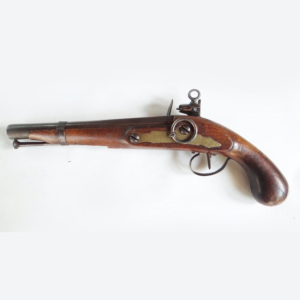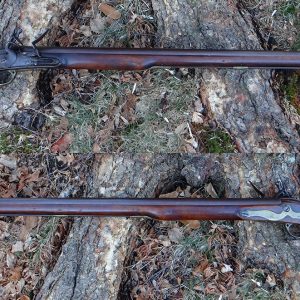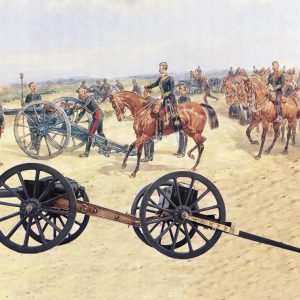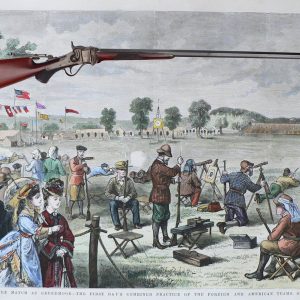



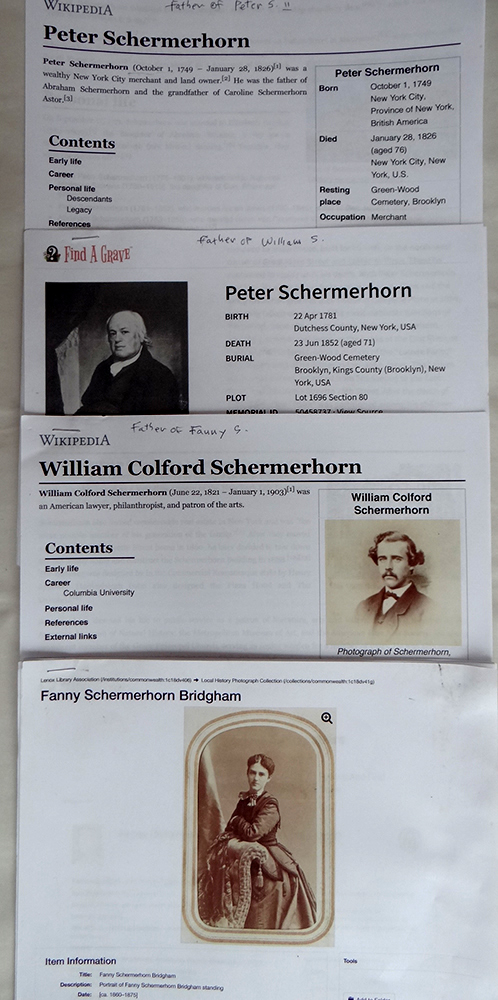































Fine Pair of Cased Flintlock Pistols Owned by Peter Schermerhorn
An exceptional American historical cased pair of ‘John Willets’, Birmingham, England traveling pistols, 1770, property of the important early American ship captain and New York Citry ship owner/merchant Peter Schermerhorn and passsed down through the Schermerhorn family to his great granddaughter Fanny Schermerhorn Bridgham
THE PISTOLS. This pair of original flintlock ‘Traveling Pistols’ were made by ‘John Willets ‘a noted Birmingham. England gunmaker active 1743-1789. Willets was primarily a British military contractor known for producing Brown Bess muskets, military blunderbusses, and even some Ferguson breech loading rifles for the British Ordnance Dept. He also had contracts with the Hudson’s Bay Company. He is well known among collectors of French & Indian War and American Revolutionary War arms. Judging from surviving examples his private purchase/commercial production was a smaller part of his business. This pair of Willets pistols displays excellent form and very high quality workmanship. In style they are early examples of the rounded checkered butt with flat sides made popular by Wogdon. The locks feature roller frizzens and sliding safetys but the pans have no waterproofing features. The barrels are 1/3 octagon with two stages of ring turnings – an early style going out of fashion by 1770. The engraved steel mountings with large pineapple trigger guard finials came into vogue around 1770. The locks are engraved, ‘Willets’, and the barrels bear the double crown-over-crossed-sceptres marks Tower of London proof marks of the 1770 period.
Traveling pistols are one of the less common forms of British 18th century flintlock pistols. They were fashioned as slightly scaled down military officer’s pistols with full walnut stocks and one third octagonal barrels but were still built in a substiantial .58 caliber. Traveling pistols were intended to be serious self defense weapons designed to be carried on one’s person rather than in traditional saddle holsters, consequently they would have been favored by ship captins supercargos and others needing to keep powerful weapons on their persons while operating in potentially dangerous places.
This pair of pistols and their original case are in excellent original condition. The barrels retain most of their original ribboned steel finish with fine patina. the locks retain a considerable amount of tgheir original faded casehardening. The pan interiors and frizzen faces show these pistols have seen real use but have been well cared for. The steel mountings on both pistols retain 90% of their fire blued finish with some slight aging. the checkerd walnut stocks retain nearly all their original finish and surface with excellent parinas – the grip checkering is excellent. Both pistols retain their original horn tipped ram rods, one with an iron ‘worn end, the other with a threaded end for cleaning jags.
This cased pair of pistols have been very well cared for probably due to their being with the family of their original owner from 1770 to 2018. the case is of fine Honduras mahogany featuring brass mountings and the exposed dovetail construction of the period. The case contains a fine leather covered copper powderflask with two extra compartments for balls and spare flints, an iron bullet mold, an early combination screw driver and vent pick, and a wooden cleaning rod with carved ‘jag’ at one end and iron worm at the other. The case is in excellent condition with light handling wear. It retains nearly all its original finish with excellent patina and original surface.
THE CHRONOLOGY & HISTORY. Opening the pistol case one is presented with a handwritten inscription attached to the lid; “This box and pistols belonged to my grandfather Peter Schermerhorn and were taken with him when as a young man he travelled from New York to Savannah Georgia in a ‘buggy’, Fanny Bridgham, 1888”.
There were two Peter Schermerhorns. The first Peter Schermerhorn – Born Oct 1, 1749 , NYC – died Jan 28, 1826, NYC, was known as, ‘Peter the Elder’ and would have been the original owner of this pair of Willets pistols. Peter the Elder was a successful ship captain, ship owner, and merchant in New York City. During the American Revolution ,when the British threatened NYC, Peter moved his small fleet and his family to land he owned in Duchess County, NY to avoid capture. Peter the Younger, was born there in 1781. When the British left new York the Schermerhorns returned to the city and Peter the Elder resumed and his business interests as ship owner sailing merchant vessels between New York and Charleston, South Carolina. He opened a ship Chandlery and was also elected a director of the Bank Of New York. His business expanded and he built a row of nine federal style counting houses on Fulton Street. These buildings still stand and are part of the Souith Street Seaport Museum complex in lower Manhattan.
Peter Schermerhorn the Younger was Fanny Bridgham’s grandfather – April, 22, 1781 – Duchess County, NY – died June 23, 1852. He would have been a young man during the United States’ ‘Quasi War With France’, 1798-1800 which was fought almost entirely at sea, the ‘Jefferson Embargo’ of 1807 when American ships were being borded and having sailors taken by ships of the British Royal Navy, and ‘The War Of 1812’ between the US and Britain during which the Atlantic coast was blockaded by the Royal Navy and American ships, even if they made it through the blockade, were in constant peril.
During this tempestuous period in American history Peter was a young man (18 in 1798 and 31 in 1812) in partnership with his very successful father. Fanny tells us Peter made a trip from New York to Savannah, Georgia in a ‘buggy’. During the late 18th and early 19th centuries Charleston, SC and Savannah, Georgia were the two most important seaports in the southern United States, and Schermerhorn & Sons did business there. Under normal circumstances ‘Schermerhorn & Sons’ would have conducted business with these ports by sea.
One has to wonder why a shipowner would elect to have his son make a very long, very hard, and quite hazardous trip by buggy when sailing a ship from NYC to Savannah. The trip would have been much easier and faster by ship. There must have been a very important reason for Peter the Elder to send Peter the Younger – with this pair of pistols – on such a dangerous journey. It is likely Peter the Younger was to deliver something very important, or convey special information, to someone in Savannah. Peter the Younger’s buggy trip would have been a major adventure at that time – an event important enough for the pistols to become family heirlooms and for Peter the Younger’s grandaughter to positively identify them for prosterity in 1888.
Fanny Schermerhorn Bridgham – 1846 – 1919. She was a niece of Caroline Schermerhorn Astor who was known as Mrs. Astor and was the leader of New York society during the Guilded Age. Fanny herself was a member of New York Society and spent time between NYC and Providence, RI. In 1869 Miss Schermerhorn married Samuel Willard Bridgham (1842–1915) who was himself from a prominent RI family.
This pair of fine and historical pistols which have descended in an important American family are worthy of further research as part of a public or private collection.
Price: $6850.00






